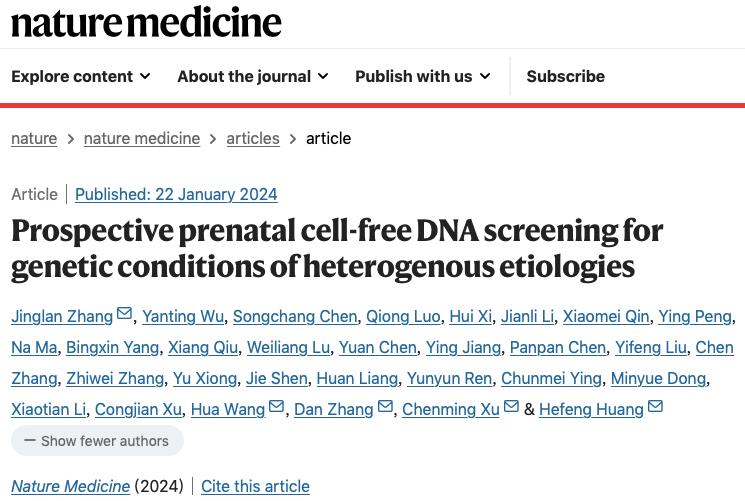January 22, 2024, Academician Huang Hefeng, together with researchers from Zhejiang University and Fudan University, published the latest clinical research results in Nature Medicine, entitled Prospective Prenatal Cell-Free DNA Screening for Genetic Conditions of Heterogeneous Etiology. Using a new generation of non-invasive prenatal screening technology developed by our team, the clinical effectiveness of prenatal screening for fetal chromosomal diseases, microdeletion microreplication syndrome and monogenic diseases was verified in a prospective multicenter cohort study.
In this study, an innovative comprehensive non-invasive prenatal screening technology-synergistic allele-targeted enrichment sequencing was used to comprehensively screen different types of fetal genetic variation by detecting free DNA in maternal plasma. Studies have shown that this comprehensive non-invasive prenatal screening can accurately identify the fetal pathogenic variation at chromosome and monogenic level in high-risk pregnancy, which may improve the prenatal risk assessment of heterogeneous causes of genetic diseases, realize more accurate prenatal and perinatal medical management, and fill the gap in prenatal screening for new dominant monogenic diseases.

Research publication link:
https://www.nature.com/articles/s41591-023-02774-x#citeas
Academician Qiao Jie, Executive Vice President of Peking University/Director of Medical Department, Academician Yang Zhenglin, Dean of Sichuan Provincial People’s Hospital, Dean of Chongqing Women and Children Hospital (Chongqing Maternal and Child Health Hospital), and Qi Hongbo, Chairman-designate of Perinatal Branch of Chinese Medical Association, commented on this achievement.
Academician Qiao Jie pointed out in his comments, "The biggest innovation of this clinical study by Academician Huang Hefeng is to include monogenic diseases in the scope of non-invasive prenatal screening. This progress not only significantly improves the detection rate of fetal genetic diseases, but also provides safer, timely and accurate information for pregnant women and doctors in the decision-making and management of pregnancy, marking an important breakthrough in the field of genetic diseases and birth defects prevention and control."
Academician Yang Zhenglin pointed out in his comments that "the dominant monogenic disease caused by new mutation is the weak link in the current prenatal screening, and it is an inevitable trend for NIPT to include it in the comprehensive screening of fetal cfDNA. The research of Academician Huang Hefeng’s team not only proposed a novel and efficient technical path, but also demonstrated the clinical effectiveness of related technologies, providing important theoretical and practical basis for further improving prenatal diagnosis and prevention and treatment of hereditary birth defects. "
Dean Qi Hongbo pointed out in his comments, "This three-in-one comprehensive screening method has significantly improved the detection rate and demonstrated high accuracy, which proves its great potential in clinical application. If this method can be popularized in clinic, it will effectively fill the gap in prenatal screening for dominant monogenic diseases, which is of great practical significance for improving China’s prenatal screening system and prevention and control of birth defects. "
What is prenatal non-invasive screening?
Noninvasive prenatal screening (NIPS): It is a kind of prenatal screening technology. The screening targets are mainly trisomy 21, trisomy 18 and trisomy 13, which are common fetal chromosomal diseases. After 2013, it quickly integrated into the prenatal screening system and became the most effective and widely used prenatal screening method.
At present, non-invasive prenatal screening (NIPS) detects aneuploidy or microdeletion/microdeletion syndrome by analyzing fetal free DNA(cfDNA) in maternal peripheral blood. Because most of the maternal plasma cfDNA comes from the mother, it is difficult to detect fetal specific variation in high maternal background, and many hereditary diseases can not be detected at present.
What is comprehensive non-invasive prenatal screening technology?
Comprehensive non-invasive prenatal screening (cfDNA comprehensive screening) technology covers three main human genetic variations, namely chromosome aneuploidy, chromosome microdeletion and single gene variation, which expands the detection range of non-invasive prenatal screening and improves the detection accuracy, and is of great significance in the field of prenatal screening.
What did the study find?
The team established a new targeted enrichment method-COATE-SEQ (Figure 1), which realized multi-dimensional analysis of maternal and fetal free DNA, solved many technical defects of the first generation NIPT, and realized non-invasive prenatal detection of fetal chromosome aneuploidy, chromosome microdeletion syndrome and monogenic genetic disease at the same time for the first time.

Figure 1 New generation NIPS technical process
This study evaluated the clinical effectiveness and increased detection efficiency of this new generation NIPS technology through a multicenter prospective clinical study lasting nearly 2 years.
During the period from April 24th, 2021 to September 10th, 2022, 1191 pregnant women (age ≥20 years, single pregnancy ≥12 weeks, abnormal fetal structure (including NT≥3mm), high risk of NIPT or maternal serological screening, or high risk of genetic diseases due to previous pregnancy history) from three maternity hospitals in different provinces of China were included in the study, and all the participants underwent a comprehensive prenatal cfDNA screening. Finally, the screening results of 1,090 pregnant women who met the criteria for ovulation were analyzed. Pathogenic genetic variation was detected in 135 cases (12.4%) of pregnancy through comprehensive cfDNA screening, which was confirmed by diagnostic tests, including 89 aneuploidies, 9 microdeletions and 37 single gene variations (Figure 2). Compared with the current standard screening for chromosomal abnormalities (NIPT), the detection rate of diagnostic genetic variation in comprehensive cfDNA screening increased by 60.7%, the sensitivity was 98.5% (95% CI, 94.3%-99.7%), and the specificity was 99.3% (95% CI, 98.4%-99.7%).

Figure 2 Detection rate of genetic variation in pregnancy with abnormal fetal structure
Among 876 cases of pregnancy with abnormal fetal structure, 98 cases (11.2%) detected diagnostic gene variation. Among them, 42 cases were autosomal aneuploidy (42.9%), 13 cases were sex aneuploidy (13.3%), 6 cases were microdeletion (6.1%) and 37 cases were single gene (37.8%). B in 876 cases of pregnancy with abnormal fetal structure, the detection rate of diagnostic genetic variation was the highest in lymphatic or hydrops abnormalities (36.9%), followed by skeletal abnormalities (24.7%) and multiple system abnormalities (23.3%). The highest detection rate of chromosomal abnormalities was lymphatic or hydrops abnormalities (32.6%), followed by multiple system abnormalities (19.2%), thickening of the transparent layer behind the neck (8.8%), heart defects (5.7%) and craniofacial abnormalities (5.7%). The highest detection rate of single gene abnormality is skeletal abnormality (23.5%), followed by lymphatic or hydrops abnormality (4.3%), multi-system abnormality (4.1%), FGR(2.9%) and brain developmental abnormality (2.2%).
What is the significance of this research?
Incorporating chromosome aneuploidy, chromosome microdeletion syndrome and monogenic genetic diseases into fetal cfDNA screening is beneficial to prenatal diagnosis, can be used as an auxiliary tool for early identification in the first trimester of pregnancy, supplement the current imaging-based methods, and is also beneficial to prenatal screening and perinatal management. When pregnant women with abnormal fetus choose to continue pregnancy and refuse invasive surgery, this screening becomes particularly important. Comprehensive NIPS screening can provide more accurate prenatal screening for a wide range of hereditary diseases and provide valuable help for risk assessment and timely management of pregnancy.
Correspondents of this study are Zhejiang University/Director of Key Laboratory of Reproductive Genetics/Academician Huang Hefeng and Researcher Zhang Jinglan of Fudan University, Zhang Dan of Obstetrics and Gynecology Hospital affiliated to Zhejiang University Medical College, Xu Chenming of Obstetrics and Gynecology Hospital affiliated to Fudan University and Wang Hua of Hunan Children’s Hospital. The co-first authors are Luo Qiong, the Obstetrics and Gynecology Hospital affiliated to Zhejiang University Medical College, Wu Yiting and Chen Songchang, the Obstetrics and Gynecology Hospital affiliated to Fudan University, and Xi Hui, the Maternal and Child Health Hospital of Hunan Province. Chen Yuan, Jiang Ying, Chen Panpan, Liu Yifeng and Dong Min Yue also participated in the study.
It is the eternal pursuit of the development of non-invasive prenatal screening and the long-term research and development goal of the medical community to screen more kinds of important fetal genetic diseases simultaneously with a tube of maternal peripheral blood more accurately and efficiently.

Obstetrics and Gynecology Hospital affiliated to Zhejiang University School of Medicine is the leading unit of Zhejiang Prenatal Diagnosis Center, Zhejiang Fetal Medical Diagnosis and Treatment Center, Zhejiang Prenatal Diagnosis (Screening) Quality Control Center, Zhejiang Obstetric Medical Quality Control Center, Zhejiang Critical Pregnant Women Treatment Center, Zhejiang Remote Fetal Heart Monitoring and Interpretation Center, Zhejiang Labor Analgesia Technical Guidance Center, Zhejiang Maternal and Child Nursing Specialist Nurse Training Base and other institutions.
Obstetrics and Gynecology Hospital affiliated to Zhejiang University School of Medicine is a national key clinical specialty, a key (supporting) discipline in Zhejiang Province, and the leader unit of Zhejiang perinatal health care cooperation group. The annual delivery volume exceeds 20,000 person-times, among which the high-risk pregnancy exceeds 80%, the proportion of serious, difficult and critical cases exceeds 35%, and the success rate of maternal rescue basically reaches 100%. It has formed sub-specialties such as maternal medicine, fetal medicine and general obstetrics, and opened more than 20 specialty clinics such as fetal medicine clinic, prenatal diagnosis consultation clinic and gestational diabetes clinic. It has a very high rescue success rate for difficult and critical patients such as pregnancy complicated with refractory heart failure, pre-eclampsia critical state, acute fatty liver of pregnancy, amniotic fluid embolism, adult respiratory distress syndrome, severe prenatal hemorrhage and severe postpartum hemorrhage. In the basic and clinical research of pregnancy-induced hypertension, the diagnosis and treatment of intrahepatic cholestasis of pregnancy, the treatment of intrauterine growth retardation, the prognosis evaluation of intrauterine brain diseases and intrauterine kidney diseases, intrauterine fetal surgery such as fetal mirror, delivery room surgery, gestational diabetes mellitus, various fetal intrauterine monitoring, painless delivery and other fields, fruitful results have been achieved; He has accumulated rich clinical experience and management ability in premature delivery, premature rupture of membranes, twins, cervical incompetence, early-onset preeclampsia and early-onset intrahepatic cholestasis of pregnancy. It is an early large-scale unit in China to carry out prenatal diagnosis and fetal monitoring, and has established a prenatal screening system-prenatal diagnosis system-prenatal diagnosis management system.To make a multi-level cross-study on complicated and difficult fetal birth defects.
Source | Zhejiang University Women’s Hospital
Read the original text
关于作者